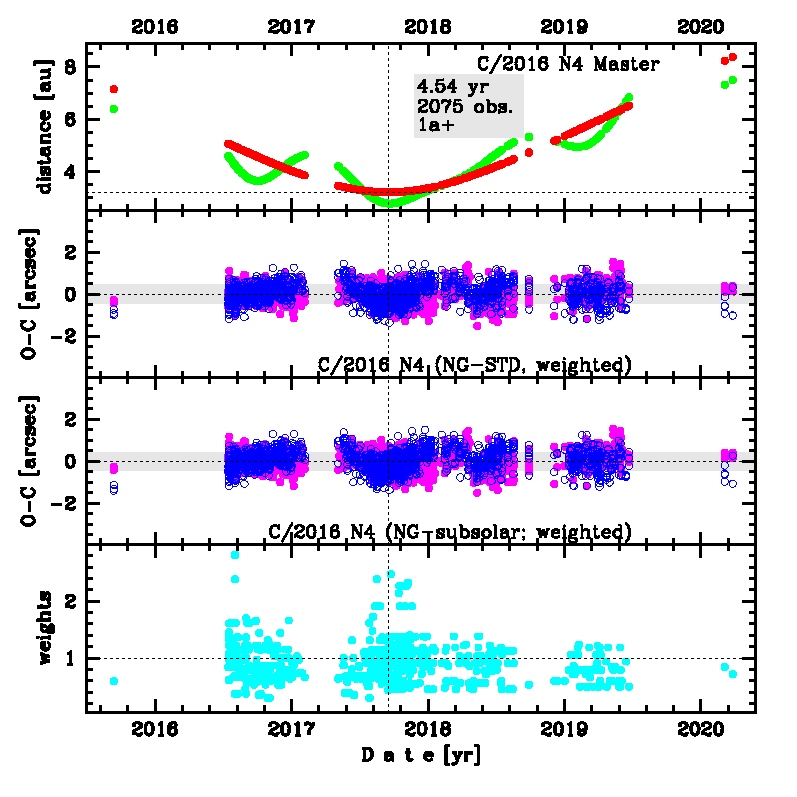C/2016 N4 Master
more info
Comet C/2016 N4 was discovered on 15 July 2016 with Mobile Astronomical System of the Telescope-Robots (MASTER), that is about months after its perihelion passage.
Some prediscovery images of this comet were found: taken on 11 September 2015 by ISON-SSO Observatory (Siding Spring).
Solutions given here are based on data spanning over 4.54 yr in a range of heliocentric distances: 7.14 au – 3.199 au (perihelion) – 8.37 au.
NG orbits using full data-arc as well as independently using pre-perihelion and post-perihelion data are determinable.
See also Królikowska and Dones 2023.
| solution description | ||
|---|---|---|
| number of observations | 2075 | |
| data interval | 2015 09 11 – 2020 03 26 | |
| data type | perihelion within the observation arc (FULL) | |
| data arc selection | entire data set (STD) | |
| range of heliocentric distances | 7.14 au – 3.20 au (perihelion) – 8.37 au | |
| type of model of motion | NH - non-gravitational orbits for water sublimation from subsolar point | |
| data weighting | YES | |
| number of residuals | 4096 | |
| RMS [arcseconds] | 0.43 | |
| orbit quality class | 1a+ | |
| previous orbit statistics, both Galactic and stellar perturbations were taken into account | ||
|---|---|---|
| no. of returning VCs in the swarm | 5001 | * |
| no. of escaping VCs in the swarm | 0 | |
| no. of hyperbolas among escaping VCs in the swarm | 0 | |
| previous reciprocal semi-major axis [10-6 au-1] | 177.84 – 178.75 – 179.62 | |
| previous perihelion distance [au] | 3.18829 – 3.18843 – 3.18856 | |
| previous aphelion distance [103 au] | 11.13 – 11.19 – 11.24 | |
| time interval to previous perihelion [Myr] | 0.4149 – 0.4179 – 0.4211 | |
| percentage of VCs with qprev < 10 | 100 | |

Upper panel: Time distribution of positional observations with corresponding heliocentric (red curve) and geocentric (green curve) distance at which they were taken. The horizontal dotted line shows the perihelion distance for a given comet whereas vertical dotted line — the moment of perihelion passage.
Middle panel(s): O-C diagram for a given solution (sometimes in comparison to another solution available in CODE), where residuals in right ascension are shown using magenta dots and in declination by blue open circles.
Lowest panel: Relative weights for a given data set(s).
Middle panel(s): O-C diagram for a given solution (sometimes in comparison to another solution available in CODE), where residuals in right ascension are shown using magenta dots and in declination by blue open circles.
Lowest panel: Relative weights for a given data set(s).
| previous_g orbit statistics, here only the Galactic tide has been included | ||
|---|---|---|
| no. of returning VCs in the swarm | 5001 | * |
| no. of escaping VCs in the swarm | 0 | |
| no. of hyperbolas among escaping VCs in the swarm | 0 | |
| previous reciprocal semi-major axis [10-6 au-1] | 177.83 – 178.75 – 179.62 | |
| previous perihelion distance [au] | 3.19143 – 3.19159 – 3.19174 | |
| previous aphelion distance [103 au] | 11.13 – 11.19 – 11.24 | |
| time interval to previous perihelion [Myr] | 0.4148 – 0.4179 – 0.4211 | |
| percentage of VCs with qprev < 10 | 100 | |